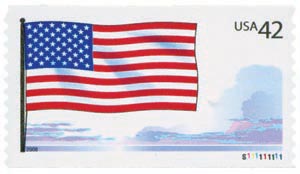
# 4313-22 - 2011 First-Class Forever Stamp - Flags of Our Nation: 5th Set
City: Columbus, Ohio
Printed By: Sennett Security Products
The Flags Of Our Nation Series
The state flags had been honored on US stamps once before, in 1976 as part of the Bicentennial Series (US #1633-82). Those stamps marked an important first – they were America’s first 50-stamp se-tenant. The sheet featured all of the state flags in the order the states were admitted to the Union.
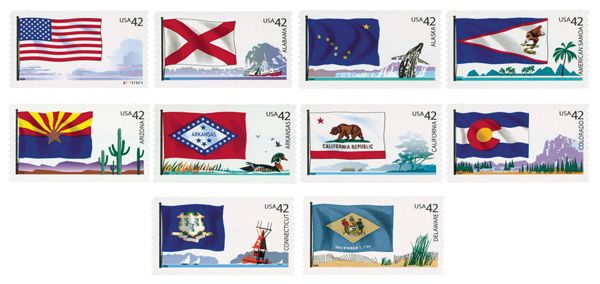
In 2008, the USPS again decided to honor the state flags but in a different format. These stamps represented a US postal first. They have the beauty and historic significance of commemorative stamps, but were issued as se-tenant (face-different attached) definitive coil stamps.
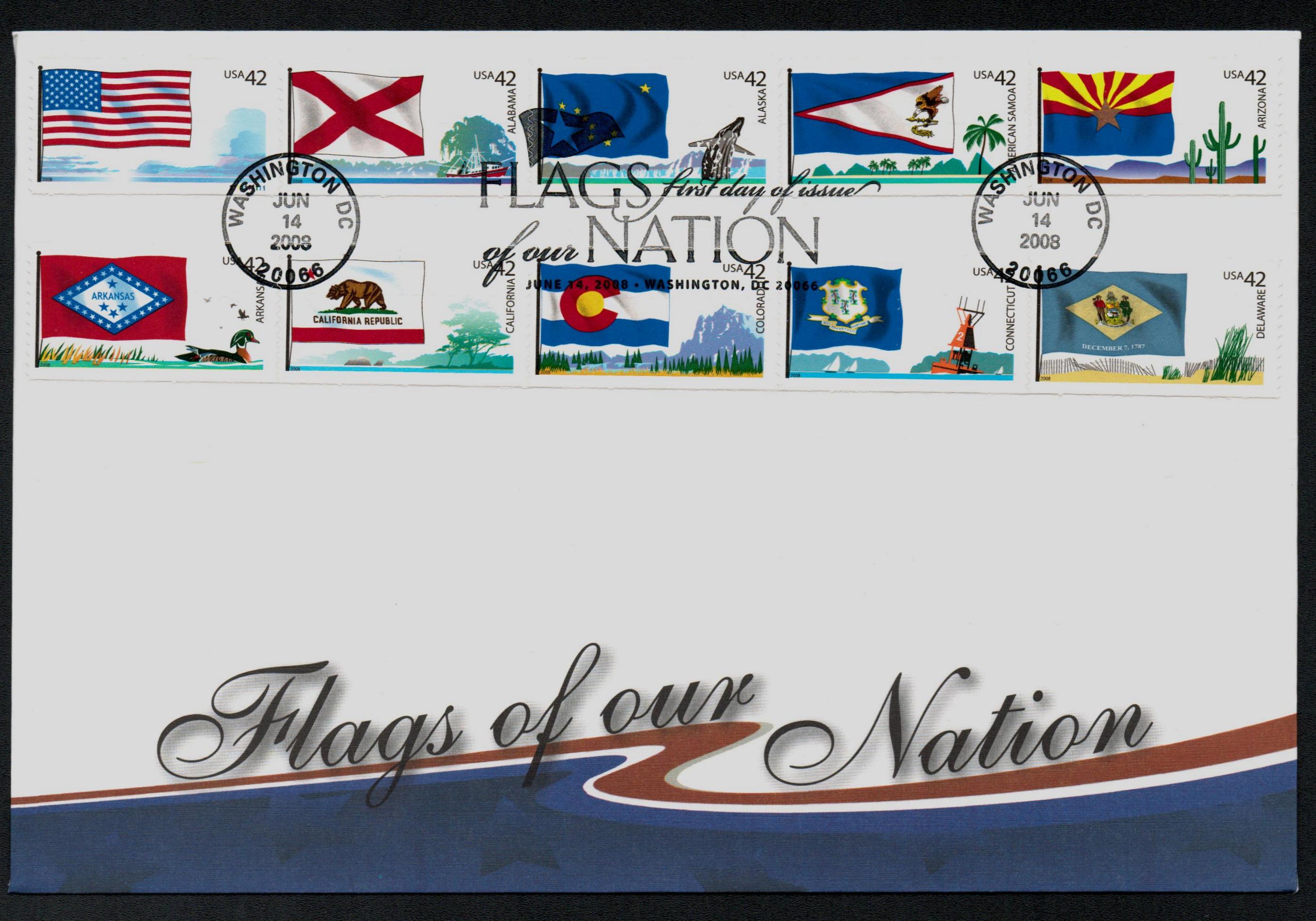
The new series was called “Flags of Our Nation” and would consist of 60 stamps total – 50 featuring state flags, five territorial flags, the District of Columbia flag, and four US flags flying over American landscapes described in “America the Beautiful.” The stamps in the new set would be issued in alphabetical order by state or territory. Each stamp would feature a flag and a “snapshot” from the state or territory. These snapshots would include scenic areas, plants, animals, and more.
The first set of stamps was issued on Flag Day, June 14, 2008 at the National Postal Museum in Washington, DC. It featured the flags of Alabama through Delaware, American Samoa, and the American flag with “spacious skies.”
In speaking about the stamps, a USPS representative said, “Flags are our nation’s greatest symbols for unity and pride and the values we hold dear. The Postal Service is proud to present this tribute as we honor our nation’s flags.” That same day, special events were held in the nine state capitals whose flags were featured in that first set of stamps.
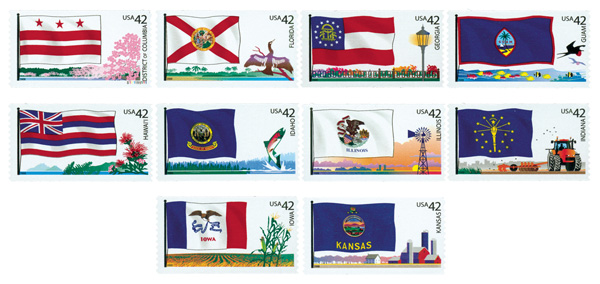
The second set in the series was issued later in 2008, on September 2. As with the first set, there were special ceremonies in the state capitols of those states featured on this set of stamps. The stamps in this set featured the flags of Florida through Kansas, the District of Columbia and Guam.
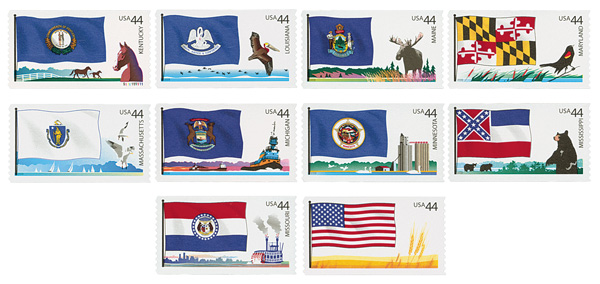
Initially, two sets of 10 stamps were supposed to be issued each year for three years. However, in 2009 it was decided that each year would only include the issue of one set of 10 stamps. The third set was issued on August 6, 2009 at the American Philatelic Society Stamp Show in Pittsburgh, Pennsylvania. These stamps featured the flags of Kentucky through Missouri as well as the US flag with “amber waves of grain.”
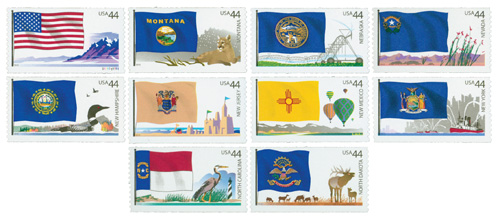
The fourth issue in the series was released on April 16, 2010 at the Mega Stamp Show in New York City. These stamps featured the flags of Montana through North Dakota with the US flag above “purple mountain majesties.”
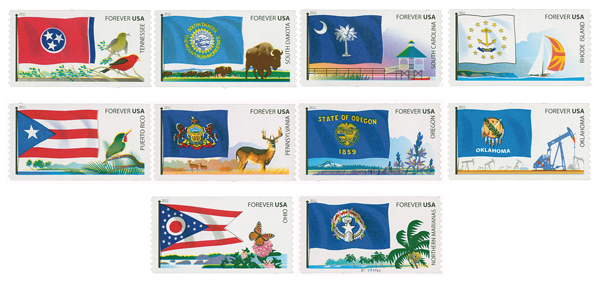
The fifth set was issued on August 11, 2011, at the American Philatelic Society Stamp Show, in Columbus Ohio. These were the first in the series to be issued as Forever stamps. Featured on these stamps were the flags of Ohio through Tennessee, Puerto Rico, and the Northern Mariana Islands.
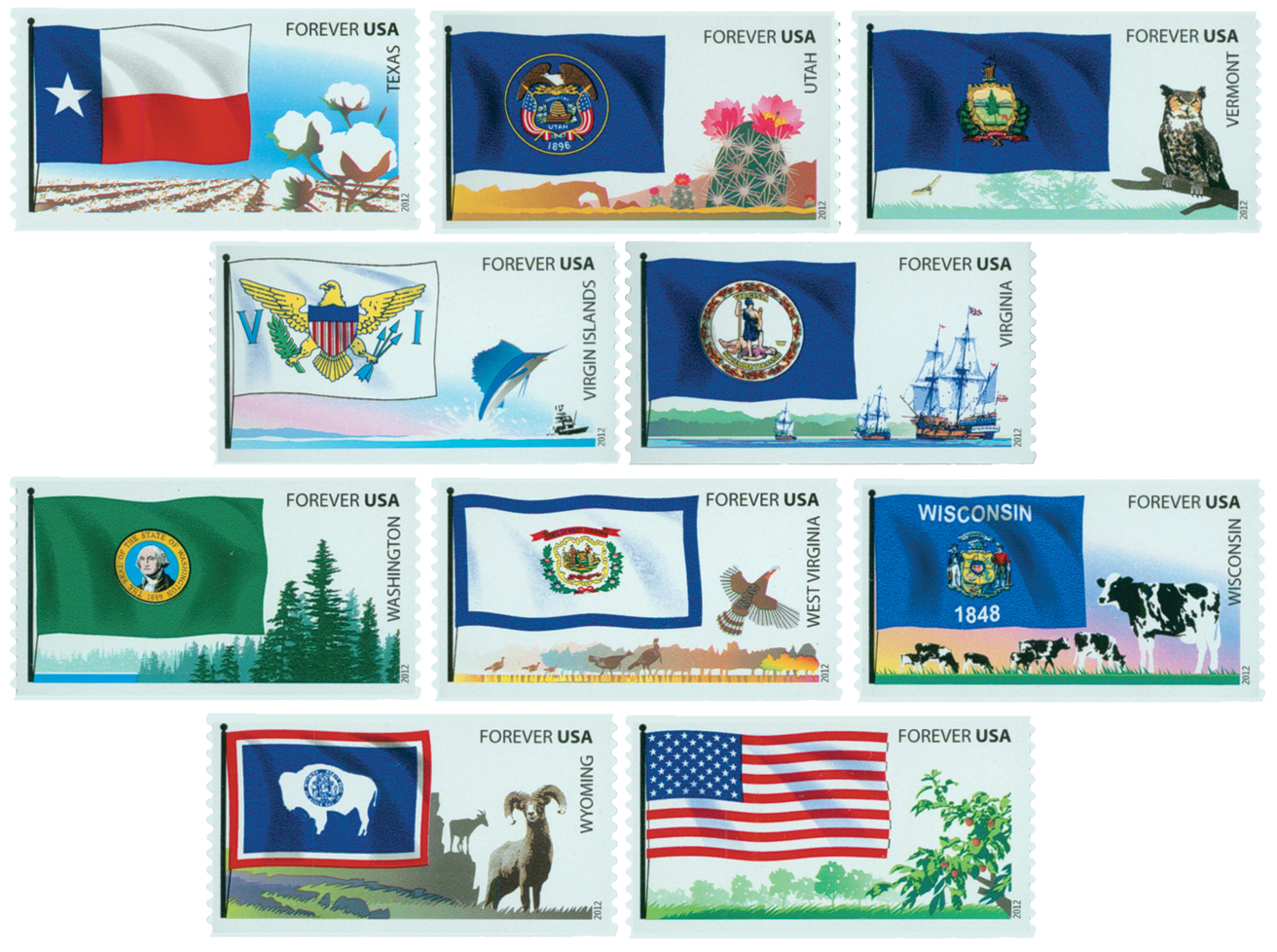
The series came to a close on August 16, 2012, with the sixth and final set. These stamps were issued at the American Philatelic Society Stamp Show in Sacramento, California. Featured on these stamps were the flags of Texas through Wyoming, the Virgin Islands, and the US flag with “the fruited plain.”
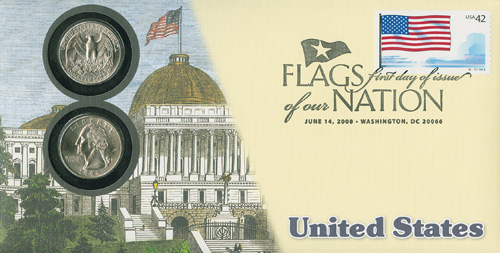
Click here for more Flags of Our Nation Coin Covers as well as single stamps and sets.
Click here to get the complete set of 60 Flags of Our Nation stamps in one convenient set.
City: Columbus, Ohio
Printed By: Sennett Security Products
The Flags Of Our Nation Series
The state flags had been honored on US stamps once before, in 1976 as part of the Bicentennial Series (US #1633-82). Those stamps marked an important first – they were America’s first 50-stamp se-tenant. The sheet featured all of the state flags in the order the states were admitted to the Union.

In 2008, the USPS again decided to honor the state flags but in a different format. These stamps represented a US postal first. They have the beauty and historic significance of commemorative stamps, but were issued as se-tenant (face-different attached) definitive coil stamps.

The new series was called “Flags of Our Nation” and would consist of 60 stamps total – 50 featuring state flags, five territorial flags, the District of Columbia flag, and four US flags flying over American landscapes described in “America the Beautiful.” The stamps in the new set would be issued in alphabetical order by state or territory. Each stamp would feature a flag and a “snapshot” from the state or territory. These snapshots would include scenic areas, plants, animals, and more.
The first set of stamps was issued on Flag Day, June 14, 2008 at the National Postal Museum in Washington, DC. It featured the flags of Alabama through Delaware, American Samoa, and the American flag with “spacious skies.”
In speaking about the stamps, a USPS representative said, “Flags are our nation’s greatest symbols for unity and pride and the values we hold dear. The Postal Service is proud to present this tribute as we honor our nation’s flags.” That same day, special events were held in the nine state capitals whose flags were featured in that first set of stamps.

The second set in the series was issued later in 2008, on September 2. As with the first set, there were special ceremonies in the state capitols of those states featured on this set of stamps. The stamps in this set featured the flags of Florida through Kansas, the District of Columbia and Guam.

Initially, two sets of 10 stamps were supposed to be issued each year for three years. However, in 2009 it was decided that each year would only include the issue of one set of 10 stamps. The third set was issued on August 6, 2009 at the American Philatelic Society Stamp Show in Pittsburgh, Pennsylvania. These stamps featured the flags of Kentucky through Missouri as well as the US flag with “amber waves of grain.”

The fourth issue in the series was released on April 16, 2010 at the Mega Stamp Show in New York City. These stamps featured the flags of Montana through North Dakota with the US flag above “purple mountain majesties.”

The fifth set was issued on August 11, 2011, at the American Philatelic Society Stamp Show, in Columbus Ohio. These were the first in the series to be issued as Forever stamps. Featured on these stamps were the flags of Ohio through Tennessee, Puerto Rico, and the Northern Mariana Islands.

The series came to a close on August 16, 2012, with the sixth and final set. These stamps were issued at the American Philatelic Society Stamp Show in Sacramento, California. Featured on these stamps were the flags of Texas through Wyoming, the Virgin Islands, and the US flag with “the fruited plain.”

Click here for more Flags of Our Nation Coin Covers as well as single stamps and sets.
Click here to get the complete set of 60 Flags of Our Nation stamps in one convenient set.







